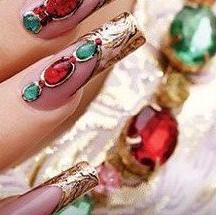Liquid stones on the nails look as if they were created not by a nail designer, but by a jeweler. Opals, rubies, amethysts and emeralds made from special polymers look like elaborate inlays. Very often they are supplemented by a drawing in another author’s technique - “Casting”, with which you can achieve the full impression of a precious metal and stone product, or “Velvet sand”, which allows the nails to look like embroidery on expensive oriental fabric.
The full manufacturing technology of such jewelry can be found, for example, at the courses of Elena Miroshnichenko. Nails with liquid stones that look like real precious and semiprecious stones will decorate the portfolio of any nail designer.
What is needed to make such a beauty?
Not only technical skills, but also special materials will be required. The polymer "Liquid stones" is a special product. It guarantees the durability and speed of manufacturing design.
How to make "liquid stones"
For work you need:
- Thin and wide brushes for painting with colored gels.
- Tear-off foil.
- Protective gel without dispersion.
- Stained glass gel.
- Colored gels.
The sequence of design execution "liquid stones" on the background of "cast" patterns
With the chosen shade of a colored gel, for example, ivory, draw a line in a jacket and dry in a lamp for two minutes. Then we fix the background with a protective coating - and again 2 minutes in the lamp. With a black gel specially designed for the "Casting" technique, using a thin brush, draw lines resembling forged patterns. They should be neat, but not too thin, rather resembling a sausage, otherwise the pattern will not print later. We draw the area in which the future stone will be located. When the image is ready, we also fix it in the lamp. A piece of the tear-off foil is pressed with the matte side to the nail, we sharply tear it off. Brilliant material will remain on previously drawn lines. The impression of metal forging. Of course, the stones do not have to be supplemented with patterns in the "Casting" technique - this is just one of the options.
Then proceed to work on the stone. First you need all the same color gels. The color is selected so that subsequently, through transparent stained glass gel, it looks natural and imitates the natural beauty of stones. For example, black under red will give the impression of a thickening red that can be seen in rubies. You can mix several colored gels. So, we take a thin brush and color gels randomly paint over the area of the future stone. This layer is also fixed in the lamp. Then comes the turn of the stained glass gel. Previously applied paint will shine through it. Two layers: color gel

plus stained glass - this is what will give the future stone its complex playing color. The stained glass gel layer also needs to be held under the lamp. Our creation already looks like a stone, but it lacks depth - it is necessary to create volume. For this, a sculpted gel is taken. It is thick enough to put a drop of it. This "drop" is also fixed in the lamp. We cover the finished design with a protective gel without dispersion and last time we dry the drawing.
Is it possible to carry out liquid stones on nails independently, using commercially available products?
Of course, the leaders of schools and courses assure that no. Of course, nothing prevents the masters from experimenting and trying, but you must always remember that experiments require time and money.